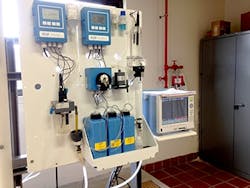Water treatment chemistry can be complex. Knowing how multiple factors in any treatment system work together can be the difference between great water and a world of problems. One area where this is especially true is in the interaction of ammonium and chlorine levels in a chloramination program. Knowing all the relevant levels is just the starting point of determining whether you need to make adjustments.
For many facilities the answer has turned out to be a combination of the Swan AMI Codes II CC disinfectant monitor and the Swan AMI ISE with ammonium electrode.
Analyzers, Outputs Produce Results
The Swan AMI Codes II CC is a versatile colorimetric analyzer that can measure free chlorine, monochloramines and total chlorine, in addition to combined chlorine and pH. The Swan AMI ISE analyzer can be used with a variety of ion-selective electrodes, including fluoride and nitrate, but when used with an ammonium electrode, it provides real-time information on chemical dosing efficiency in the chloramination process.
Both analyzers come as complete systems, pre-mounted on a panel and ready for operation. They come standard with two 4-20 outputs but can be supplied with a third output or even Profibus/Modbus capabilities. When the data of the two analyzers is combined in a SCADA system, the resulting measure ensures proper levels of chlormamine and calculated residual ammonia.
Shaun Sharrett is vice-president of sales for SWAN Analytical USA. Sharrett can be reached at [email protected] or 847.229.1290.



